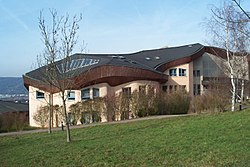Waldorf education
| Part of a series on |
| Anthroposophy |
|---|
| General |
| Anthroposophy · Rudolf Steiner Goetheanum · Anthroposophical Society |
| Anthroposophically inspired work |
| Waldorf education · Biodynamic agriculture Anthroposophical medicine Camphill Movement · Eurythmy |
| Philosophy |
| Philosophy of Freedom Social threefolding |
Clik here to view.

Waldorf school in Trier, Germany
Waldorf education (also known as Steiner or Steiner-Waldorf education) is a humanistic approach to pedagogy based upon the educational philosophy of the Austrianphilosopher Rudolf Steiner, the founder of anthroposophy. Learning is interdisciplinary, integrating practical, artistic, and conceptual elements.[1] The approach emphasizes the role of the imagination in learning,[2][3][4][5]:69 developing thinking that includes a creative as well as an analytic component.[6][7] The educational philosophy’s overarching goals are to provide young people the basis on which to develop into free, morally responsible[8][9] and integrated individuals,[2][10][11] and to help every child fulfill his or her unique destiny, the existence of which anthroposophy posits.[12][13] Schools and teachers are given considerable freedom to define curriculawithin collegial structures.[14]
The first Waldorf school was founded in 1919 to serve the children of employees at the Waldorf-Astoria cigarette factory in Stuttgart, Germany. As of 2010 there were 995 independent Waldorf schools located in sixty countries throughout the world;[15] as of 2001 there were 1400 kindergartens and 120 institutions for special education world-wide.[16] There are also Waldorf-based public (state) schools, charter schools, and homeschooling environments;[2] in addition, other state and private schools are increasingly using methods drawn from Waldorf education.[17][18]
Contents[hide] |

